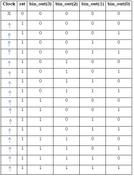CD4060 Binary Counter & Oscillator: Pinout and Applications
Advertisement
The CD4060 is a versatile integrated circuit that combines a 14-stage binary counter and an oscillator. It is widely used in timing and frequency division applications due to its reliability and ease of configuration. The IC can be configured to work as an oscillator or a frequency divider, making it ideal for clock generation, pulse generation, and timing applications.
Features of CD4060
- Operating Voltage: Wide voltage range, typically 3V to 15V.
- Low Power Consumption: CMOS technology ensures low power usage.
- Built-in Oscillator: It has an integrated RC oscillator with external resistor and capacitor for frequency control.
- Binary Counter: 14-stage ripple-carry binary counter for dividing the oscillator frequency.
- Reset Pin: Allows resetting of the counter at any time to restart counting.
- Frequency Control: Adjustable frequency based on external components, offering stable timing over a wide range.
- Output Pins: Provides several frequency-divided output pins from Q4 to Q14.
CD4060 Pinout Diagram
The figure below depicts the CD4060 pinout diagram, and the table describes all the pin details.

| Pin number | Description |
|---|---|
| 1 | Q12 |
| 2 | Q13 |
| 3 | Q14 |
| 4 | Q6 |
| 5 | Q5 |
| 6 | Q7 |
| 7 | Q4 |
| 8 | Vss |
| 9 | φ0 |
| 10 | (φ0)‘ |
| 11 | φ1 |
| 12 | RESET |
| 13 | Q9 |
| 14 | Q8 |
| 15 | Q10 |
| 16 | VDD |
In the table, Q4 to Q14 are binary counter outputs.
Application as a Binary Counter and Oscillator
The CD4060’s 14-stage counter increments with every oscillator pulse. Each output stage (Q4 to Q14) represents a binary bit, with the frequency at each stage being half of the previous stage, effectively dividing the oscillator frequency by powers of two.
In oscillator mode, the CD4060 generates a stable square wave at a frequency set by an external resistor (R) and capacitor (C).
Application: LED Blinking Circuit
- Description: A simple LED blinking circuit using the CD4060’s oscillator and frequency divider to flash LEDs at intervals.
- Configuration: Connect a resistor and capacitor to set the oscillator frequency, choose an output pin (such as Q10 or Q12), and connect an LED with a suitable current-limiting resistor to this pin.
- Operation: The LED will blink at a rate determined by the chosen output frequency division, useful in visual indicators, timing lights, or warning signals.
Conclusion
The CD4060 IC is ideal for projects that need reliable timing and counting functions. Its stable oscillator and multiple frequency outputs allow it to serve various applications in digital electronics and timing circuitry. `
Advertisement
 RF
RF

